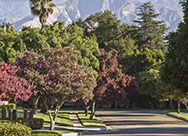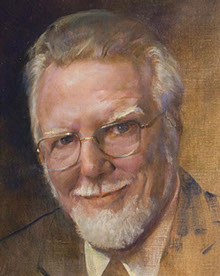The Award-Winning Yard

In our old age my wife and I have returned to Southern California. I was born and raised in the San Fernando Valley, and my wife, born and raised in Denmark, is an honorary native, having fallen in love with the palm trees silhouetted against the red dawn when she flew into LAX about 50 years ago. Now, after almost 40 years of living in Ohio, we’re back, this time living in Redlands, in an unpretentious house in an ungated Homeowner Asociation, and stunned by how everything has changed. The population has burgeoned, likewise the building, and the greenness, and the freeways which streak the landscape like a Jackson Pollack painting. California and Californians -- how all has changed! To top it off, when we left for Ohio I could hear OK; I return as deaf as a coot.
The most visible change is in the several clustered valleys of Southern California and the adjacent extensive unnamed low-lying flatlands framed by the mountain ranges and foothills. They're now green and lush.
That's remarkable because the area is naturally arid. It does rain but only in the winter, occasionally but sometimes heavily causing flash floods. For most of the year there are no real rivers, only dry riverbeds – arroyos. As a kid I would hear on the radio of all those summer baseball games in the East being “called on account of rain,” and would shout back at the sports announcer, “whudyamean! It doesn’t rain in summer!” Some of the mountains defining the valleys are high and in winter always heavily snowcapped, with good, but brief, melt runoff. So the valleys are dry and dusty, and, in my day, barren of growth except for patches of lackadaisical sagebrush, half-hearted nondescript weeds, tumbleweeds in season, no redeeming features. There were scattered towns, reminiscent of Biblical villages, just fly spots on a map fifty shades of gray.
Because of one almost catastrophic flash flood that happened about 75 years ago (I remember it), California constructed a vast system of rain and runoff control, a network of massive and unbelievably extensive aqueducts. The forward looking engineers, also concerned about the inevitable periods of drought, included at least a thousand reservoirs and large man-made lakes, such as Big Bear Lake. Besides that, water was famously imported from real rivers in adjacent states. The system was one of the engineering marvels of the world, the materialization of the unquenchable California spirit, to fend off the rare flash flood and forever to feed innumerable Rain Bird sprinklers and garden hoses, and the innumerable lawns and bird-of-paradise flowers and agapanthuses. In those days folks were proud of such accomplishments. Proud of the greenness which, in arid California, had been made sustainable. The system of huge cement drains is forgotten or, to the several recent generations, unknown, being for the most part covered over with freeways and traffic. But the legacy of controlled water remains. These once vacant forlorn valleys have been transformed into one solid suburb with lush, profligate greenery of every sort known to the Monrovia Nurseries, Home Depot, and landscape designers.
Redlands, where we now live, is a pretty little town situated at the eastern extremity of this stretch, with the magnificent San Bernardino Mountains in the background, just across the valley. The town is old by California standards, but somehow even in my day had managed to procure water and thus orange groves. The town has always been famous for those groves, green gold bringing genteel affluence and a fancy public library and a fine university and a good symphony and many parks and tangles of roses and, lining wide streets, tall palms, memorable even when not seen as silhouettes against a dawn, interspersed with crimson crepe myrtles, almost as famous as the orange groves.
There are still surprisingly extensive residual orchards stretching from the un-developed east of town to the bare foothills, and the landscaping of not a few old veranda-Victorians or Spanish style tiled villas is not the usual Pittosporum tobira, Bird of Paradise, and roses, but thick blackish green ranks of orange trees, a residential landscaping scheme unique to Redlands. Naturally Redlands is where we would move upon retirement.
We found a smallish HOA, 6 minutes from downtown, carved circa 1970 from an orange grove. There's not an orange tree in the development. Instead there are camphor trees, liquid ambers, runs of African sumac, mature ash, 2 flowering magnolia trees, a jacaranda, a few mature Aleppo pines, some sycamores and 2 or 3 authentic California live oaks – not a single orange tree, or eucalyptus, or banana tree -- all scattered upon a continuous strip of lawn that separates individually owned properties, that legally is the association’s “common property.” To keep this belt of grass perfectly maintained and green, the association contracts with the ForeverGreen Landscaping Service, which employs only expert aliens and advanced and generous irrigation technology, and likes to showcase our greenness as a demonstration of its expertise. Redlands, all of it, our little part of it, our neighborhood, is historically and currently lovely and green.
All, that is, except for one small yard, just one block south on Bienvenida Street, on the corner of El Famoso Blvd, the most conspicuous spot in the neighborhood. You drive by and cringe. Untended, unwatered, the stunted colorless long-dead grass and a few shreds of shriveled unidentifiable plants or pitiful weeds have remained mummified. Treeless, totally treeless. When we moved here five years ago we were told that despite numerous complaints and petitions and legal threats to the occupants, whether senile or criminal no one seemed to know, the awful sight had remained as dry and barren as the pyramids. On the plus side, this spot of blight sets off the greenness of the prosperous neighborhood.
But now, in 2015, Another Drought has struck. Only token rain only for a minute or two, meager drizzle, subliminal dew. The winter-long snow that dependably covers the mountains, so picturesque, has not been seen for the last 2 winters. Drought isn't unknown to California at all, which is exactly why the massive California reservoir system was created, to render the state sustainable in times of drought with hardly a faded petunia.
But this one is worse than usual. Also very different from the farsighted and golden days of California is California's new save-the-planet worldview which has taken over San Francisco and the media, Sacramento and the legislature, and the Sierra Club came down from the Sierras and became global activists and reached into every community and HOA. To divert the Colorado River is water grabbing and immoral. And even when the water level of reservoirs goes low, it's endangered bugs that deserve first dibs. Dams must be dynamited. The California Green movement leaves lawns anything but green. Lushness is embarrassing and not considered sustainable.
So Redlands has imposed water restrictions. Our HOA watering timers have been accordingly set lower. Spreading out like lava flows are swaths of colorlessness defiling our ForeverGreen lawn. Petunias are wilting.
Last night our HOA had an emergency meeting to deal with the catastrophe. Being as deaf as the lawn is dry, I caught only snatches of the spirited, and, as near as I could tell, dispirited discussion. Of the world-famous California water reserve system, the reservoirs, the aqueducts, not a peep. If I heard him right, old Greg, an ex-fireman, was moaning, “Our lawn is still getting too much water! We’ve got to demand that ForeverGreen turn the timers down even more.” Meanwhile Matt, an old retired pastor speaking in a tired, tremulous old ministerial tone I could hardly understand, seemed to be proclaiming, “California will be destroyed! … global warming! … doubters be damned! we all have got to realize that our old expectations have got to be lowered. For far too long we have indulged shameful extravagance …Oh, how thankful we should be to have leading us… [I expected the Biblical Joseph to be pointed to, and how he saved the Egyptians from the drought, or maybe Winston Churchill and WWII and victory gardens, no, strike the gardens] … Jerry Brown governor! ...compassion… compassion... even for the smelt.”
Then young Jeremy, a super-hero comic strip letterer, stood up and, gesticulating, proclaimed excitedly, and so clearly that I caught almost every bit of it: “But hey! There's an example of what everybody's lawns should be in this crisis, just down the street, we drive by it all the time – at the corner of El Famoso and Bienvenida, isn’t it? I propose that an award – let’s call it the Governor’s Brown Award -- be posted on that yard for all to see. The citation could read: ‘Presented in honor of the region’s most sustained and exemplary awareness of global disaster and compliance with restitutory regulatory measures, and for the most authentic restoration and virtual reincarnation of the original culture and soul of Southern California as it was before Big Industry, Big Walmart, Big Developers, Big Artichoke and Big Reservoirs moved in and corrupted the earth.’ Hey! It ought to be published in the Redlands Daily Orange and, why not, Sunset Magazine, …hey! the mayor could come, or, hey! Governor Brown himself! And …” Film crews? Did I hear "film crews? Brian Williams? "Moved, seconded, carried!"

